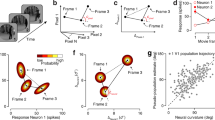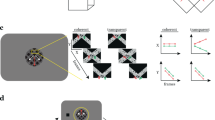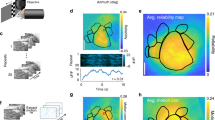Abstract
A critical step in the interpretation of the visual world is the integration of the various local motion signals generated by moving objects. This process is complicated by the fact that local velocity measurements can differ depending on contour orientation and spatial position. Specifically, any local motion detector can measure only the component of motion perpendicular to a contour that extends beyond its field of view1,2. This “aperture problem”3 is particularly relevant to direction-selective neurons early in the visual pathways, where small receptive fields permit only a limited view of a moving object. Here we show that neurons in the middle temporal visual area (known as MT or V5) of the macaque brain reveal a dynamic solution to the aperture problem. MT neurons initially respond primarily to the component of motion perpendicular to a contour's orientation, but over a period of approximately 60 ms the responses gradually shift to encode the true stimulus direction, regardless of orientation. We also report a behavioural correlate of these neural responses: the initial velocity of pursuit eye movements deviates in a direction perpendicular to local contour orientation, suggesting that the earliest neural responses influence the oculomotor response.
This is a preview of subscription content, access via your institution
Access options
Subscribe to this journal
Receive 51 print issues and online access
$199.00 per year
only $3.90 per issue
Buy this article
- Purchase on Springer Link
- Instant access to full article PDF
Prices may be subject to local taxes which are calculated during checkout



Similar content being viewed by others
References
Wallach, H. Uber visuell wahrgenommene Bewegungsrichtung. Psychol. Forsch. 20, 325–380 (1935).
Wuerger, S., Shapley, R. & Rubin, N. “On the visually perceived direction of motion,” by Hans Wallach: 60 years later. Perception 11, 1317–1367 (1996).
Marr, D. & Ullman, S. Directional selectivity and its use in early visual processing. Proc. R. Soc. Lond. B. 211, 151–180 (1981).
Movshon, J. A. & Newsome, W. T. Visual response properties of striate cortical neurons projecting to area MT in macaque monkeys. J. Neurosci. 16, 7733–7741 (1996).
Movshon, J. A., Adelson, E. H., Gizzi, M. S. & Newsome, W. T. The analysis of moving visual patterns. Exp. Brain Res. Suppl. 11, 117–151 (1986).
Rodman, H. R. & Albright, T. D. Single-unit analysis of pattern-motion selective properties in the middle temporal visual area (MT). Exp. Brain Res. 75, 53–64 (1989).
Stoner, G. R. & Albright, T. D. Neural correlates of perceptual motion coherence. Nature 358, 412–414 (1992).
Albright, T. D. & Desimone, R. Local precision of visuotopic organization in the middle temporal area (MT) of the macaque. Exp. Brain Res. 65, 582–592 (1987).
Maunsell, J. H. & Van Essen, D. C. Functional properties of neurons in middle temporal visual area of the macaque monkey. I. Selectivity for stimulus direction, speed, and orientation. J. Neurophysiol. 49, 1127–1147 (1983).
Albright, T. D. Direction and orientation selectivity of neurons in visual area MT of the macaque. J. Neurophysiol. 52, 1106–1130 (1984).
Pack, C. C. & Born, R. T. Latency of direction tuning in cortical area MT of alert macaque. Soc. Neurosci. Abstr. 25, 673 (1999).
Newsome, W. T., Wurtz, R. H., Dürsteler, M. R. & Mikami, A. Deficits in visual motion processing following ibotenic acid lesions of the middle temporal visual area of the macaque monkey. J. Neurosci. 5, 825–840 (1985).
Groh, J. M., Born, R. T. & Newsome, W. T. How is a sensory map read out? Effects of microstimulation in visual area MT on saccades and smooth pursuit eye movements. J. Neurosci. 17, 4312–4330 (1997).
Lisberger, S. G. & Movshon, J. A. Visual motion analysis for pursuit eye movements in area MT of macaque monkeys. J. Neurosci. 19, 2224–2246 (1999).
Krauzlis, R. J. & Lisberger, S. G. Temporal properties of visual motion signals for the initiation of smooth pursuit eye movements in monkeys. J. Neurophysiol. 72, 150–162 (1994).
Robinson, D. A method of measuring eye movement using a scleral search coil in a magnetic field. IEEE Trans. Biomed. Eng. 10, 137–145 (1963).
Lorençeau, J., Shiffrar, M., Wells, N. & Castet, E. Different motion sensitive units are involved in recovering the direction of moving lines. Vision Res. 33, 1207–1217 (1993).
Yo, C. & Wilson, H. R. Perceived direction of moving two-dimensional patterns depends on duration, contrast and eccentricity. Vision Res. 32, 135–147 (1992).
Masson, G. S., Rybarczyk, Y., Castet, E. & Mestre, D. R. Temporal dynamics of motion integration for the initiation of tracking eye movements at ultra-short latencies. Vis. Neurosci. 17, 753–767 (2000).
Beutter B. R. & Stone, L. S. Human motion perception and smooth eye movements show similar directional biases for elongated apertures. Vision Res. 38, 1273–1286 (1998).
Hildreth, E. C. The Measurement of Visual Motion (MIT Press, Cambridge, Massachusetts, 1984).
Watanabe, T. & Cole, R. Propagation of local motion correspondence. Vision Res. 35, 2853–2861 (1995).
Lidèn, L. H. & Pack, C. C. The role of terminators and occlusion cues in motion integration and segmentation: A neural network model. Vision Res. 39, 3301–3320 (1999).
Chey, J., Grossberg, S. & Mingolla, E. Neural dynamics of motion grouping: From aperture ambiguity to object speed and direction. J. Opt. Soc. Am. 14, 2570–2594 (1997).
Wilson, H. R., Ferrera V. P. & Yo, C. A psychophysically motivated model for two-dimensional motion perception. Vis. Neurosci. 1, 79–97 (1992).
Duncan, R. O., Albright, T. D. & Stoner, G. R. Occlusion and the interpretation of visual motion: perceptual and neuronal effects of context. J. Neurosci. 20, 5885–5897 (2000).
Born, R. T., Groh, J. M., Zhao, R. & Lukasewycz, S. J. Segregation of object and background motion in visual area MT: effects of microstimulation on eye movements. Neuron 26, 725–734 (2000).
Acknowledgements
We thank P. Abrams for technical assistance, and J. Assad and T. Watanabe for comments on a previous version of the manuscript. This work was supported by a McDonnell-Pew Cognitive Neuroscience grant to C.C.P., and grants from NIH/NEI and The Giovanni Armenise-Harvard Foundation for Scientific Research to R.T.B.
Author information
Authors and Affiliations
Corresponding author
Rights and permissions
About this article
Cite this article
Pack, C., Born, R. Temporal dynamics of a neural solution to the aperture problem in visual area MT of macaque brain. Nature 409, 1040–1042 (2001). https://doi.org/10.1038/35059085
Received:
Accepted:
Issue Date:
DOI: https://doi.org/10.1038/35059085
This article is cited by
-
The effect of impaired velocity signals on goal-directed eye and hand movements
Scientific Reports (2023)
-
Canonical circuit computations for computer vision
Biological Cybernetics (2023)
-
Attention amplifies neural representations of changes in sensory input at the expense of perceptual accuracy
Nature Communications (2020)
-
Integration of Position and Predictive Motion Signals in Aging Vision
Scientific Reports (2020)
-
Differential cortical activation during the perception of moving objects along different trajectories
Experimental Brain Research (2019)
Comments
By submitting a comment you agree to abide by our Terms and Community Guidelines. If you find something abusive or that does not comply with our terms or guidelines please flag it as inappropriate.



